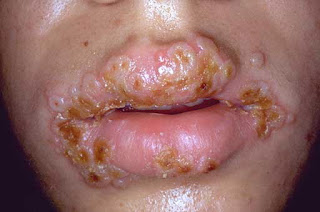Nursing Diagnosis for Herpes Simplex
Herpes simplex is a viral disease from the herpesviridae family caused by both Herpes simplex virus type 1 (HSV-1) and type 2 (HSV-2). Genital herpes affects the genitals, buttocks or anal area. Genital herpes is a sexually transmitted disease (STD). It affects the genitals, buttocks or anal area. Other herpes infections can affect the eyes, skin, or other parts of the body. The virus can be dangerous in newborn babies or in people with weak immune systems.
Genital herpes, known simply as herpes, is the second most common form of herpes. Other disorders such as herpetic whitlow, herpes gladiatorum, ocular herpes, cerebral herpes infection encephalitis, Mollaret's meningitis, neonatal herpes, and possibly Bell's palsy are all caused by herpes simplex viruses.
HSV infection causes several distinct medical disorders. Common infection of the skin or mucosa may affect the face and mouth (orofacial herpes), genitalia (genital herpes), or hands (herpetic whitlow). More serious disorders occur when the virus infects and damages the eye (herpes keratitis), or invades the central nervous system, damaging the brain (herpes encephalitis). Patients with immature or suppressed immune systems, such as newborns, transplant recipients, or AIDS patients are prone to severe complications from HSV infections. HSV infection has also been associated with cognitive deficits of bipolar disorder, and Alzheimer's disease, although this is often dependent on the genetics of the infected person.
In all cases HSV is never removed from the body by the immune system. Following a primary infection, the virus enters the nerves at the site of primary infection, migrates to the cell body of the neuron, and becomes latent in the ganglion. As a result of primary infection, the body produces antibodies to the particular type of HSV involved, preventing a subsequent infection of that type at a different site. In HSV-1 infected individuals, seroconversion after an oral infection will prevent additional HSV-1 infections such as whitlow, genital herpes, and herpes of the eye. Prior HSV-1 seroconversion seems to reduce the symptoms of a later HSV-2 infection, although HSV-2 can still be contracted.
Many people infected with HSV-2 display no physical symptoms—individuals with no symptoms are described as asymptomatic or as having subclinical herpes.
Nanda Herpes Simplex - Nursing Diagnosis
1. Impaired skin integrity related to skin inflammation, crusting, vesicles.
2. Hyperthermia related to increased hypothalamic set point.
3. Acute Pain related to infection in pain neurons, the ganglia.
4. Fatigue related to reduction of energy sources.
5. Risk for Imbalanced Nutrition, Less Than Body Requirements related to appetite down.
Acne Vulgaris
Anaphylaxis
Anemia
Angina Pectoris
Appendicitis
Asthma Bronchiale
Atelectasis
Benign Prostatic Hyperplasia
Bone Cancer
Buerger Disease
Bulimia Nervosa
Cardiac Tamponade
Cataract
Congestive Heart Failure
Dementia
Dengue Hemorrhagic Fever
Depression
Diabetes Mellitus
Diabetic Ketoacidosis
Diarrhea
Dysmenorrhea
Epilepsy
Gastritis
Gastroenteritis
Glaucoma
Gonorrhea
Headache
Hepatitis
Herpes Simplex
Hordeolum
Hyperemesis Gravidarum
Hypertension
Hypertensive Heart Disease
Kawasaki Disease
Low Back Pain
Malignant Lymphoma
Myasthenia Gravis
Osteomalacia
Peritonsillar Abscess
Pleural Effusion
Pneumonia
Pott Disease
Preeclampsia
Pulmonary Tuberculosis
Rheumatoid Arthritis
Seizures
Sepsis
Stroke
Tetanus
Thromboangiitis Obliterans
Tuberculous Spondylitis
Typhoid
Urinary Tract Infections
